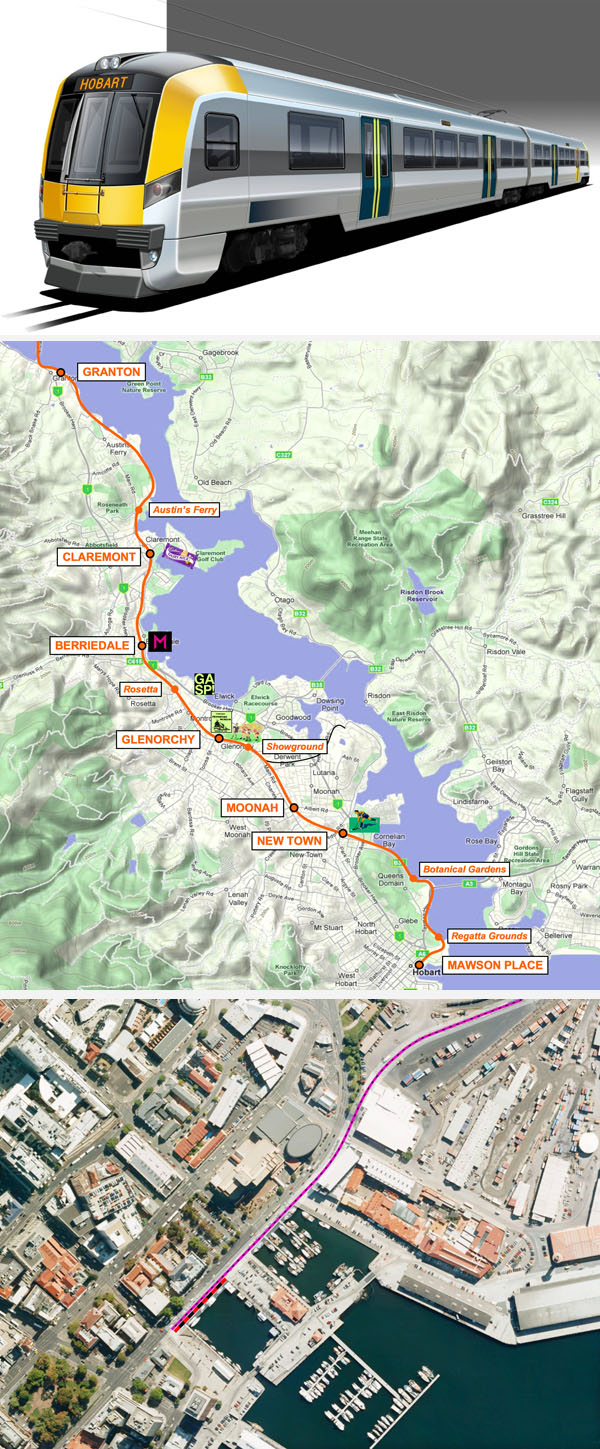Transport is Tasmania’s largest source of carbon emissions, so any idea that promises to reduce car usage is very welcome. The proposal to re-open Hobart’s northern suburbs rail line for commuter transport is now getting the attention it deserves. 9 November 2010 | Peter Boyer]
It is surely impossible to have lived in Tasmania over the past year and be unaware of certain earthworks in the vicinity of Brighton.

TOP: Artist’s impression of the type of railcar proposed for Hobart. CENTRE: Proposed route. BOTTOM: Proposed extension of the existing railway line from the Macquarie Wharf freight depot to Constitution Dock and Mawson Place.
It’s possible you haven’t seen the hectares of moonscape that used to be paddocks flanking the old Midland Highway, but you couldn’t have missed the public furore over ancient Aboriginal remains in the path of the proposed Brighton Bypass.
We’ve endured roadworks since the Romans, but never at the scale or cost of today’s schemes. Seeing the flattened Brighton landscape left me wondering how we’ve come to accept these sorts of projects as an effective use of public money.
The big machines, big dollars, big egos and big political gestures that make up the road-building juggernaut seem to have taken over not just our public works programs, but also our minds. The spreading tarmac syndrome is an affliction of public life that we seem powerless to resist.
The shelf life of such roadworks is getting shorter by the year, demanding increasingly frequent and costly upgrades as the new roads fill up with cars. But we need fewer cars, not more. Tasmanian fuel prices will inevitably escalate in the wake of peak oil, and car use is the single biggest contributor to our island’s greenhouse emissions.
To build a sustainable society we need to be flexible and innovative, to open up to alternative paradigms. We need to ask ourselves: Might some road funding be better spent on supporting local infrastructure to make the longer journey unnecessary, or on cheaper, more regular bus services? Or on a tarmac-free transport system, otherwise known as rail?
The convenience of rail helped shape metropolitan Hobart from the 1870s, when you could travel from Granton to the city in 35 minutes, less time than that taken by peak-hour car travellers and standard Metro services today. Is that progress?
The second rail line from Claremont into the city was turned into a concrete cycleway about a decade ago, making commuter cycling possible for many northern suburbs residents. The remaining single line is still used for a freight service to the Hobart waterfront.
Ben Johnston is a young Tasmanian engineer who has thought long and hard about how we can reduce road congestion while making more effective use of a long-neglected bit of infrastructure, the single rail line that runs from the Hobart wharves out to Granton, Brighton and beyond.
Johnston, who did his University of Tasmania engineering honours thesis on a Hobart suburban rail service, is president of the Northern Suburbs Rail Action Group. The group is promoting a new passenger system using the existing track, which in peak hours would bring Granton commuters into the city in about 24 minutes.
The group proposes double-ended electric rail vehicles powered by batteries, which would allow current rail lines to be used without the need to install overhead power. Modern traction batteries could be recharged within a minute at each stop along the line.
At the Hobart end, the proposal is that the line be extended from the Port of Hobart freight yards, along the edge of the Hobart waterfront to Mawson Place, from where commuters have a short walk to the city centre or to ferries for other waterfront destinations.
According to the group’s proposal, rail cars would initially service a route from Hobart to Granton, with stops at New Town, Moonah, Glenorchy, Berriedale and Claremont. The service could be extended along existing track across the Derwent River to Bridgewater and ultimately Brighton if the need was strong enough. Stations would cater for “park and ride” and feeder bus services.
Johnston estimates that installing the service, including all rail, station and level-crossing infrastructure and purchase of five battery rail vehicles of up to 400-passenger capacity, will cost $66 million — a sixth of the $410 million estimate by a 2009 government consultant for a combined railway and street tramway system.
Late last month the Minister for Sustainable Transport, Nick McKim, set up a community advisory panel to develop a business case for a suburban rail service. The panel is to assess the costs of developing and operating a rail service and likely demand.
The Hobart and Glenorchy City Councils, Brighton Council, the Sullivans Cove Waterfront Authority, the Planning Institute of Australia, Metro Tasmania, Future Transport Tasmania and the Northern Suburbs Rail Action Group are represented on the panel, chaired by University of Tasmania geographer Dr Stewart Williams.
This is not a “zero-emissions solution”. All transport has a fossil-fuel energy component. Electric vehicles need electricity, which currently comes from systems that either burn fossil fuels or were made using fossil fuels, or both. Even sailing boats, solar cars and bicycles carry embodied energy in their manufacture.
It’s a matter of degree. British figures for average usage rate rail as about six times more energy-efficient than car or air transport. Hobart is not London, and trains don’t offer the transport flexibility of cars. But given all the other considerations, this has to be worth a good look.
• At 6 pm on Thursday, the “Zero Carbon Australia Stationary Energy Plan” to achieve 100 per cent renewable energy by 2020 will have its Hobart launch at Hadleys Hotel, Murray Street. All interested people are welcome to attend. More information at www.climateactionhobart.org
